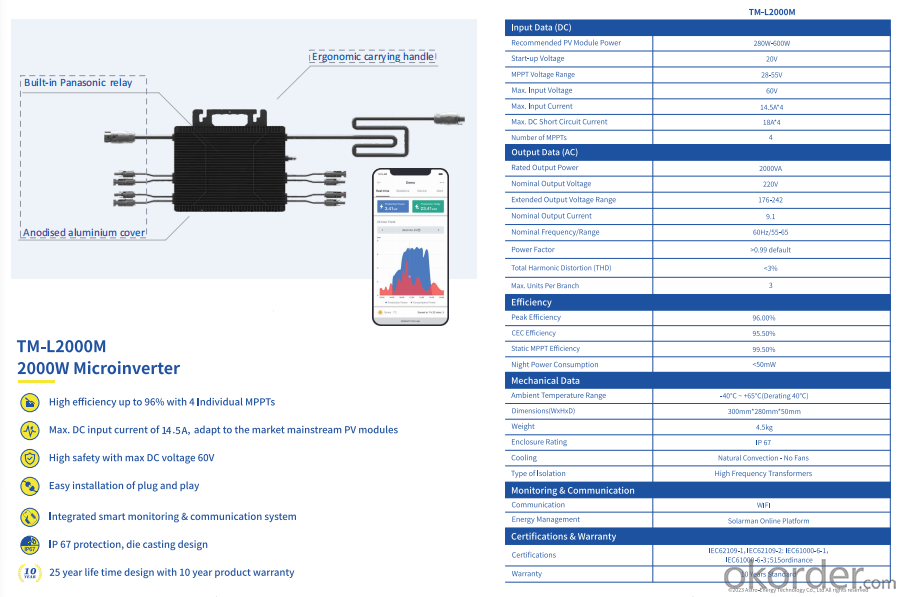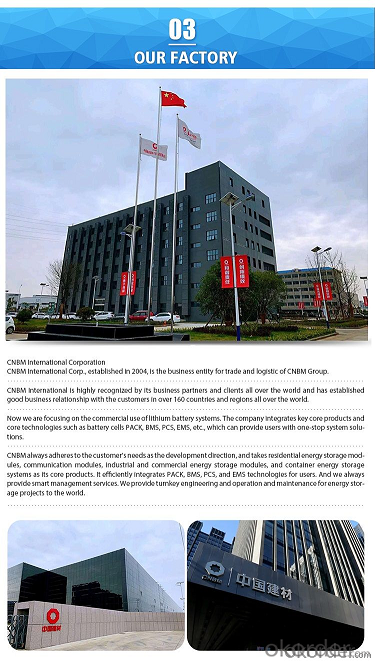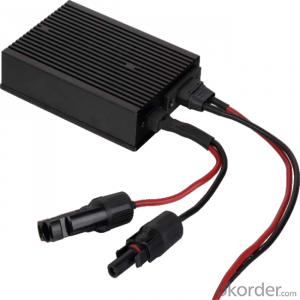Rooftop Solar Inverter - 2000W 10 Years Warranty Micro Inverters with CE Certificate for Home Balcony
- Loading Port:
- Stock in Panama
- Payment Terms:
- TT OR LC
- Min Order Qty:
- 10 pc
- Supply Capability:
- 500 pc/month
OKorder Service Pledge
OKorder Financial Service
You Might Also Like
Specification
Specification

Company presentation


Company presentation
RFQ
Q: Do you have CE?A: Yes, our products are approved by CE.Q: Is OEM &ODM available in your factory ?A: Yes, you just offer us necessary documents and then we will produce the products as your requirements.Q: What is your Packing details?A: 1.Wooden case or carton package,standard export packages2.All of the productions are inspected carefully by QC before delivery.Q: What is your Delivery time?A: Usually, we make merchandise inventory. If we have the products in stock, the delivery time is 5-10 days after receiving the deposit; If we don’t have the products in stock, we will arrange the production right now. The delivery time will be 10-30 days. It depends on the quantity of order.Q:Why choose us?A: 1. Ready To Ship 2. Sample Available 3. One-Stop Service 4. Online customization5. Many years' experiences of manufacturing and service available in 24hours
- Q: Can a solar inverter be used for off-grid systems?
- Yes, a solar inverter can be used for off-grid systems. Off-grid systems are not connected to the utility grid and rely solely on renewable energy sources like solar panels. A solar inverter converts the direct current (DC) generated by the solar panels into alternating current (AC) which can be used to power appliances and devices in an off-grid system.
- Q: Can a solar inverter convert DC power to AC power during a power outage?
- No, a solar inverter cannot convert DC power to AC power during a power outage. During a power outage, the solar inverter relies on the grid to function, and without grid power, it cannot convert DC power from the solar panels into usable AC power.
- Q: What is the difference between an on-grid and off-grid solar inverter?
- An on-grid solar inverter is designed to convert the DC power generated by solar panels into AC power that can be fed into the electricity grid. It synchronizes the solar power output with the grid's frequency and voltage, ensuring a seamless integration and allowing any excess power to be exported back to the grid. On the other hand, an off-grid solar inverter is used in standalone solar power systems that are not connected to the grid. It converts the DC power from solar panels into AC power for immediate use or storage in batteries. These systems typically require additional components like batteries and charge controllers to manage power storage and supply during periods of low solar generation or high demand. In summary, the main difference between the two types of inverters is their purpose: on-grid inverters are used for grid-tied systems, while off-grid inverters are used in standalone systems not connected to the grid.
- Q: Can a solar inverter be used in a commercial solar system?
- Yes, a solar inverter can be used in a commercial solar system. A solar inverter is an essential component of a solar system as it converts the direct current (DC) generated by the solar panels into alternating current (AC) that can be used to power commercial buildings and equipment.
- Q: What is the role of a solar inverter in voltage and frequency regulation during grid disturbances?
- Maintaining the stability and reliability of the electrical grid heavily depends on the crucial role of a solar inverter in voltage and frequency regulation during grid disturbances. To regulate and stabilize the electrical parameters, the solar inverter acts as a control device during grid disturbances like voltage fluctuations or frequency deviations. Regarding voltage regulation, the solar inverter constantly monitors the grid's voltage level and adjusts its output accordingly. It decreases its output if the grid voltage increases to avoid overvoltage conditions. Conversely, if the grid voltage decreases, the inverter increases its output to compensate and maintain a stable voltage level. This regulation guarantees that the solar inverter's voltage aligns with the grid's requirements, preventing harm to electrical equipment and ensuring the grid's safe operation. Similarly, the solar inverter also contributes to frequency regulation during grid disturbances. It continuously monitors the grid's frequency and adjusts its output frequency to match it. If the grid frequency deviates from the standard frequency, the inverter modifies its output frequency to bring it back to the desired level. This frequency regulation is vital to keep various electrical devices connected to the grid synchronized, preventing equipment damage, and ensuring the grid's stability. In summary, the solar inverter's role in voltage and frequency regulation during grid disturbances is to provide stability and reliability to the electrical grid. It acts as a control device that constantly monitors and adjusts its output to maintain the desired voltage and frequency levels. This ensures the prevention of potential damage to electrical equipment and guarantees the smooth operation of the grid.
- Q: How does a solar inverter handle voltage flicker?
- A solar inverter handles voltage flicker by constantly monitoring the grid voltage and adjusting its output to maintain a stable voltage. It uses advanced control algorithms to quickly respond to fluctuations and minimize the impact of voltage flicker on the connected devices.
- Q: Can a solar inverter be used with a solar-powered electric vehicle charging station?
- Yes, a solar inverter can be used with a solar-powered electric vehicle charging station. The solar inverter converts the DC (direct current) electricity generated by the solar panels into AC (alternating current) electricity, which is required to charge an electric vehicle. By using a solar inverter, the solar-powered electric vehicle charging station can efficiently convert and deliver the electricity generated from solar panels to charge electric vehicles.
- Q: What is the difference between a string inverter and a microinverter?
- The main difference between a string inverter and a microinverter lies in the way they convert direct current (DC) from solar panels to alternating current (AC) for use in homes or businesses. A string inverter is a centralized device that connects multiple solar panels in a series or "string" configuration. It converts the combined DC power from the entire string into AC power. This means that if one panel in the string underperforms or is shaded, it can affect the overall performance of the entire string. On the other hand, a microinverter is a small inverter that is attached to each individual solar panel. It converts the DC power from each panel into AC power independently. This allows each panel to perform optimally, even if others in the system are shaded or experiencing issues. In summary, while a string inverter handles the conversion of power from multiple panels as a whole, a microinverter ensures each panel operates at its maximum potential independently.
- Q: Can a solar inverter be used in extreme weather conditions?
- Yes, solar inverters are designed to withstand extreme weather conditions. They are typically built with durable materials and undergo rigorous testing to ensure they can operate in extreme temperatures, high humidity, and even harsh weather conditions such as heavy rain or snow. However, it is always recommended to consult the manufacturer's guidelines and take necessary precautions to protect the inverter during extreme weather events.
- Q: Are there any safety considerations when installing a solar inverter?
- Yes, there are several safety considerations when installing a solar inverter. Firstly, it is important to ensure that the inverter is installed by a qualified professional who is familiar with local electrical codes and regulations. This helps to minimize the risk of electrical hazards and ensures a safe installation. Additionally, proper grounding and bonding should be implemented to protect against electrical shock and lightning strikes. Adequate ventilation and temperature management are also important to prevent overheating and potential fire hazards. Overall, following safety guidelines and employing professional installation services are crucial to ensure the safe and efficient operation of a solar inverter system.
Send your message to us
Rooftop Solar Inverter - 2000W 10 Years Warranty Micro Inverters with CE Certificate for Home Balcony
- Loading Port:
- Stock in Panama
- Payment Terms:
- TT OR LC
- Min Order Qty:
- 10 pc
- Supply Capability:
- 500 pc/month
OKorder Service Pledge
OKorder Financial Service
Similar products
Hot products
Hot Searches
Related keywords






















